The 4 C’s of Diamonds: Evaluating Diamond Quality
How to balance the 4 Cs of diamonds to get the best bang for your buck
How to balance the 4 Cs of diamonds to get the best bang for your buck
The 4 Cs – cut, color, clarity, and carat – are the widely accepted standard characteristics for a diamond that determine its quality and value. While each ‘C’ plays a role, cut is the most important in determining a diamonds brilliance and sparkle. Finding the perfect harmony between these 4 Cs will help you balance beauty and value when looking for a diamond.
What are the 4 C’s of diamonds?
What are the main characteristics of diamonds?
What C of the 4 C’s should I prioritize when buying a diamond ring?
FAQs about diamond 4 C’s
Bottom line recommendations
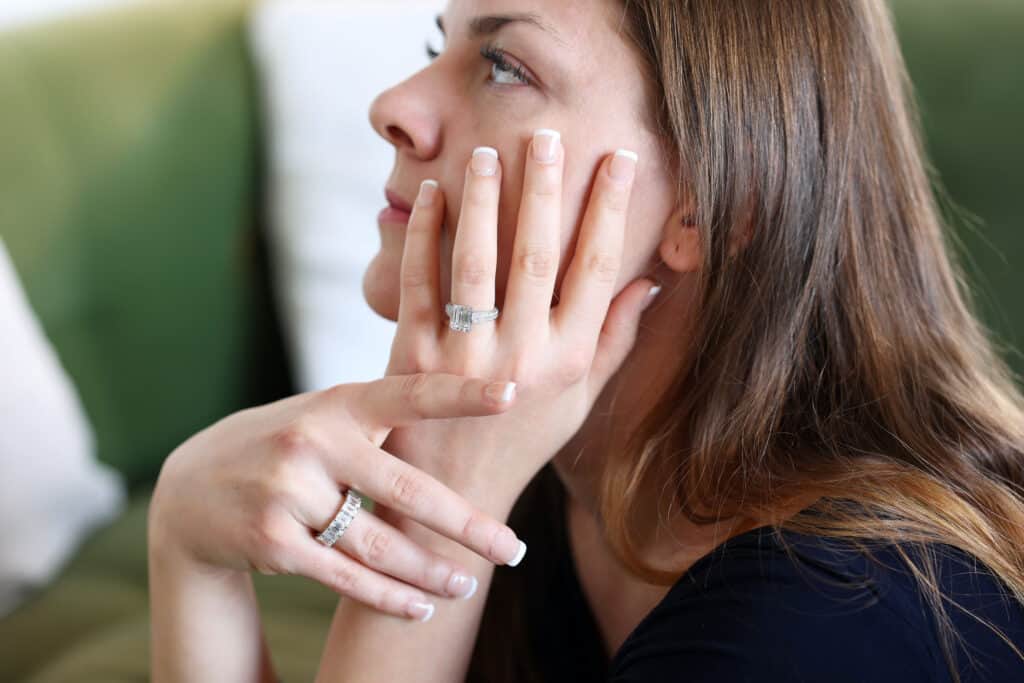
Why you should trust us
Carat refers to the diamond’s weight, such as a 2 carat or 3 carat diamond. Carat weight can be important to some, but a diamond of any carat weight can be extraordinary. It’s more critical that your diamond is well-cut.
A diamond can be colorless to the naked eye, or have some tint to it. It’s best to find a diamond that appears white once mounted in a setting. Diamond color ranges from D to Z, but there is no need to overpay for a D color diamond. An H or I color diamond, depending on the setting, will look just as clear and white as a colorless grade diamond.
Almost all diamonds have imperfections. A diamond’s clarity refers to how many blemishes and inclusions the diamond has, along with how noticeable they are. Above all, opt for a diamond that’s eye-clean, meaning you can’t see imperfections unless you put it under magnification. In our eye-clean diamond article we show you which inclusions, not grades, to look out for.
Often confused with diamond shape, cut refers to how well a diamond is cut and polished. Cut is the biggest factor that plays into how brilliant and beautiful a diamond is.
These four qualities of a diamond are the key components that impact its beauty and structure. The 4C’s interact with each other within the diamond. They dictate how the diamond appears and how high quality it is. As an example, the diamond’s ability to reflect light back to your eyes depends primarily on cut quality but also on color and clarity. (Diamond clarity vs color is a frequent question asked by many. Read more to figure out which one is more important.)
The four diamond characteristics are graded by professionals on a consistent scale, giving you a tool to evaluate diamonds. By reviewing the 4C’s of a particular diamond, you can better determine if the diamond is of high quality. GIA explains why and how diamond grades got created.
The GIA is a prominent institution with a sophisticated grading system for evaluating diamond characteristics. It is the most consistent entity and the one we recommend gaining a diamond certificate from. Each of the C’s is graded on a scale and can be evaluated for quality. Though some universal terminology and standard grading exist, it does vary by lab entity.
Gradings of the 4 C’s help determine the value of a diamond and indicate its quality. Diamond sellers often set their prices based on grading reports. Knowing the basics of these gradings is helpful when comparing two similar diamonds, but what remains most important is how the diamond appears to the naked eye—and how attractive the diamond is overall. In this sense, having a foundational understanding of the 4 C’s is imperative as a buyer, so that you can avoid spending your budget on a component that will go unnoticed.
The 4 C’s of diamonds gives you a more objective way to measure and assess the quality of a diamond. Without the 4 C’s, diamond quality is something that is hard to quantify. Any unscrupulous vendor could easily claim a diamond to be high-quality, and thus charge more than it’s worth.
It becomes much easier for consumers with a more objective guide on what makes a diamond high or low-quality. Each of the 4 C’s offers a quantifiable description of its quality in certain areas, in turn making it easier to judge whether or not it’s worth its price tag.
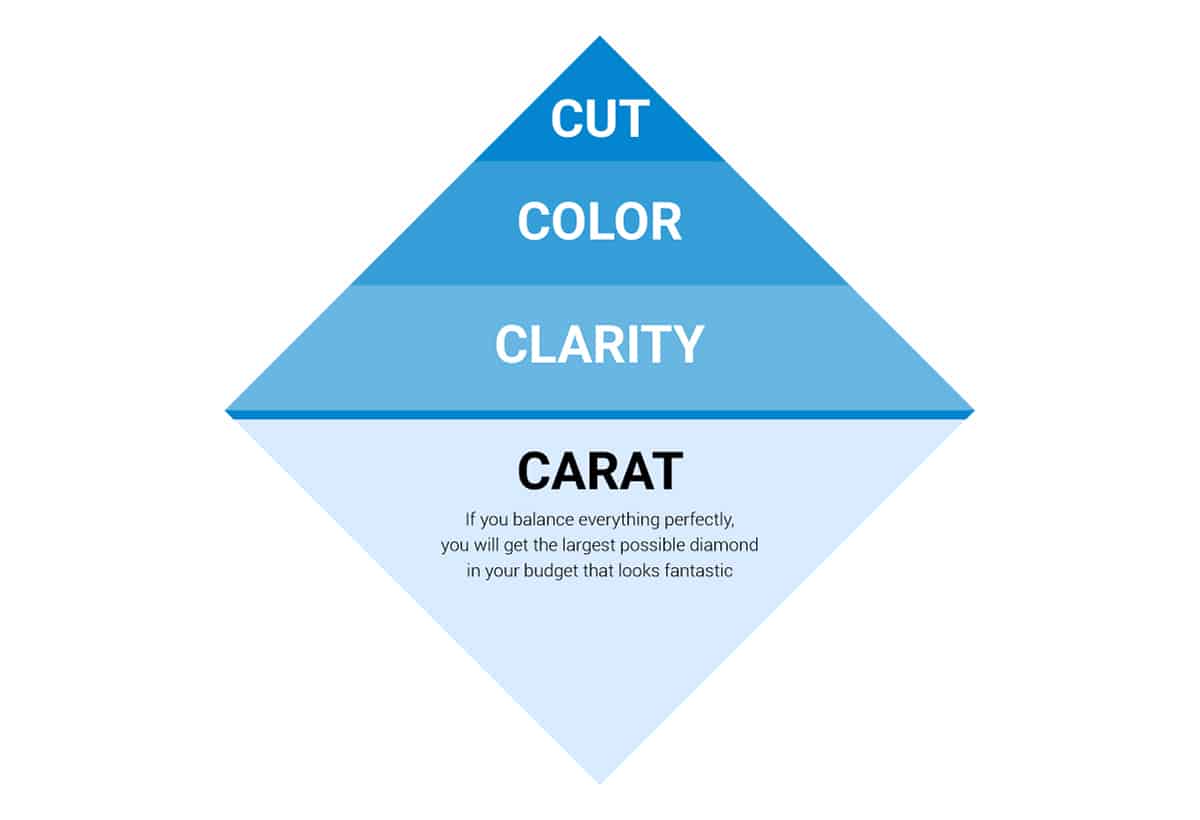
There are two major questions you need to answer; Where and what. We have an article covering where to buy your engagement ring. In this article, we are covering what characteristics you should focus on when purchasing a diamond.
Without finding the right balance between the 4cs, you will end up overpaying for certain qualities of a diamond while not spending enough on others. Let’s say you are thinking of purchasing a one carat diamond. If you balance the 4Cs you can get a stunning-looking diamond like this that is a great value. If you ignore that balance you can end up with a cheap, yet incredibly ugly, diamond like this example from James Allen. Or you can think “only the best” and spend a boatload on this exquisite diamond. But if you follow our recommendations, you can find the perfect balance of quality and value.
The ‘Cut’ is perhaps the most important aspect of a diamond quality that impacts a diamond’s beauty. Diamond cut specifically refers to the quality of a diamond’s angles, proportions, symmetrical facets, brilliance, fire, scintillation and finishing details. These factors directly impact a diamond’s ability to sparkle, along with its overall aesthetic appeal. For example, take a look at this beautiful diamond from JA and this horrific choice. The only issue differentiating the two is their cut.
The GIA diamond cut chart grades diamond cut on the scale of Ideal, Excellent, Very Good, Good, Fair and Poor. The Ideal and Excellent grades, depending on diamond shape, signify proportions and angles cut for maximum brilliance and fire.

Even if two diamonds are given the same grade on the diamond cut chart, cuts vary significantly among diamonds and diamond cutters. At times, a cutter may aim for maximum carat weight, leaving the diamond too deep or too shallow for optimal light reflection. Other times a diamond may be cut to minimize the number of inclusions, improving its clarity, but forgoing maximum sparkle. Even an Ideal cut diamond may have a yellow tint that is too noticeable and detracts from the gem’s beauty.
More importantly, though, is ensuring cut is a focal point of your diamond selection. Even a pristine 2 carat diamond with no blemishes or color tinting can be dull if it’s not cut exceptionally well. Cut is the biggest indicator of beauty and should be made a priority over the other C’s. As an example, this 1.50 carat round brilliant is graded well for each “C” but lacks a vivacious sparkle.
It’s essential to note that a top-grade designation on the diamond cut chart, such as Excellent, doesn’t necessarily indicate an outstanding diamond cut. Almost 55% of all diamonds sold online are Excellent cuts. Some are stunning, while others are mediocre. An example of an exquisite Excellent cut diamond is this 1.50 carat round brilliant from James Allen.
Also, you might have heard about triple ex diamonds (excellent cut, polish and symmetry). A lot of people think that these diamonds are worth the premium some jewelers are charging but the reality is a bit different. You can read more in our triple excellent article that explains it in more depth.
Because cut is so important to a diamond’s fundamental beauty, it’s crucial to review a diamond’s cut carefully and ask for the eye of an expert.
Diamond color is graded in terms of how white or colorless a diamond is. The GIA grades diamonds from D to Z, with D being the most colorless, and Z containing noticeable brown or yellow tint. The diamond color chart below shows how each grade looks next to each other.
While the diamond color chart provides an example of how each grade appears, it’s important to look at each diamond individually. Depending on the diamond’s cut, carat weight and shape, the color might appear different among diamonds.
The pricing of diamonds usually reflects the grade—sometimes significantly. In most cases, the naked eye cannot tell the difference between two adjacent color graded diamonds, though the price difference may be significant.
The most critical aspect with color is to determine if it appears colorless in relation to its setting. You also want to be certain that a diamond is clear of any tinting that takes away or interferes with white and colored light reflections. The K color in this cushion cut diamond from James Allen, for example, distracts from the sparkle of the diamond while this H color diamond from James Allen is radiant.
Brilliance, or sparkle, is created from the way the diamond is cut. It is not advantageous to purchase a diamond that distracts from this important principal characteristic.
As a general recommendation, review each diamond closely and ask for the assistance of an expert. This is the best way to ensure you’re not paying for a feature (i.e. too high of color grade) that will go unnoticed, or purchasing a diamond that distracts or interferes with light reflection.
Note: Certain colored diamonds are valued stones, like a fancy pink or green diamond. Color grades for these diamonds are distinctly different from traditional “white” diamonds and don’t appear on the diamond color chart.
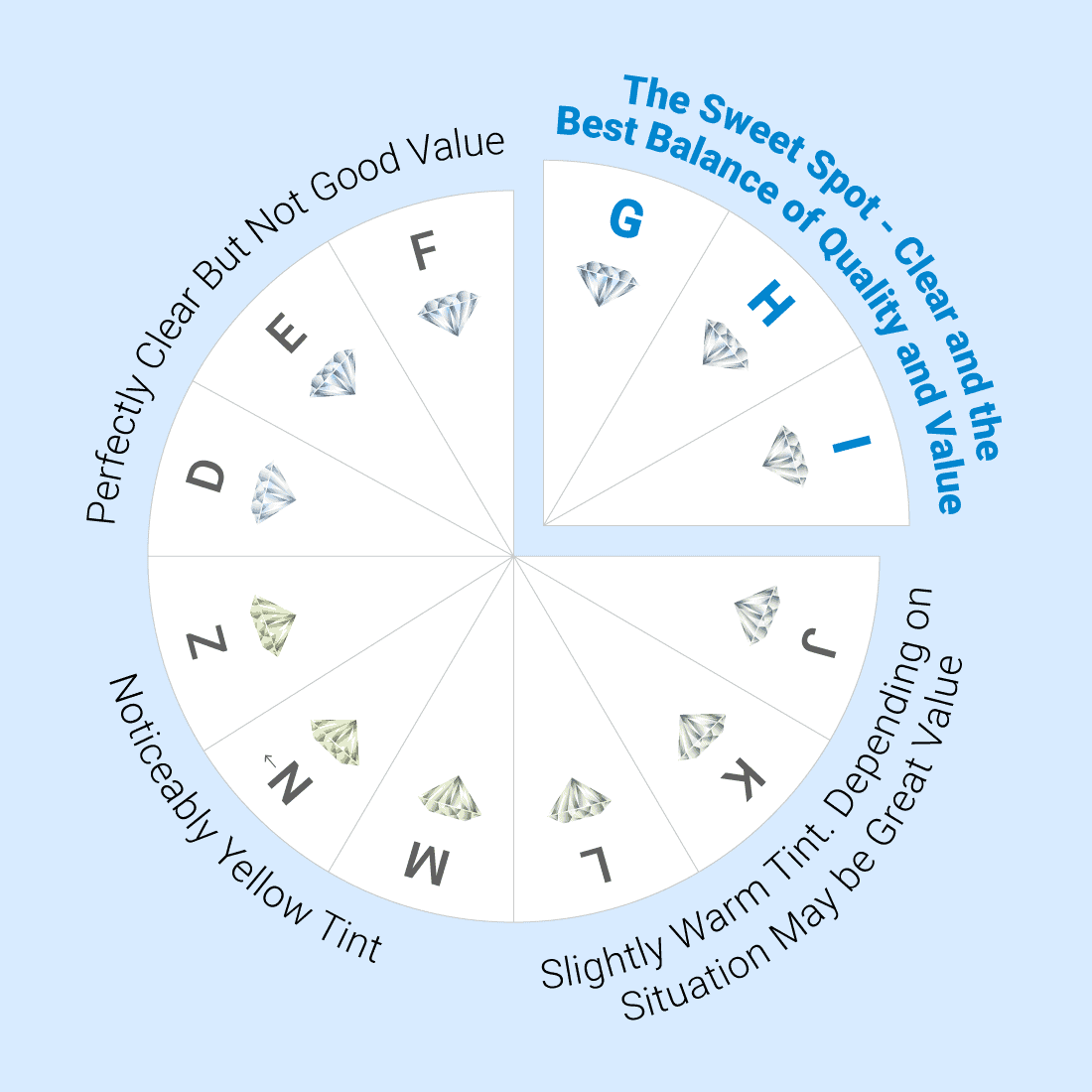
A diamond’s clarity grade evaluates how clean a diamond is from both inclusions and blemishes. Clarity is graded by the GIA on the following diamond clarity chart:
Note that each diamond differs slightly. Rather than sticking to a particular grade on the diamond clarity chart, review each diamond to see if you notice imperfections.
This diamond clarity grading scale shows and sums up each clarity grade. Watch how the visibility of the inclusions changes in the image on the right.
As you work your way across the diamond clarity chart, you’ll notice how more inclusions and blemishes are visible. Not all imperfections are visible to the naked eye, though. That’s why it’s important to look at each individual diamond.
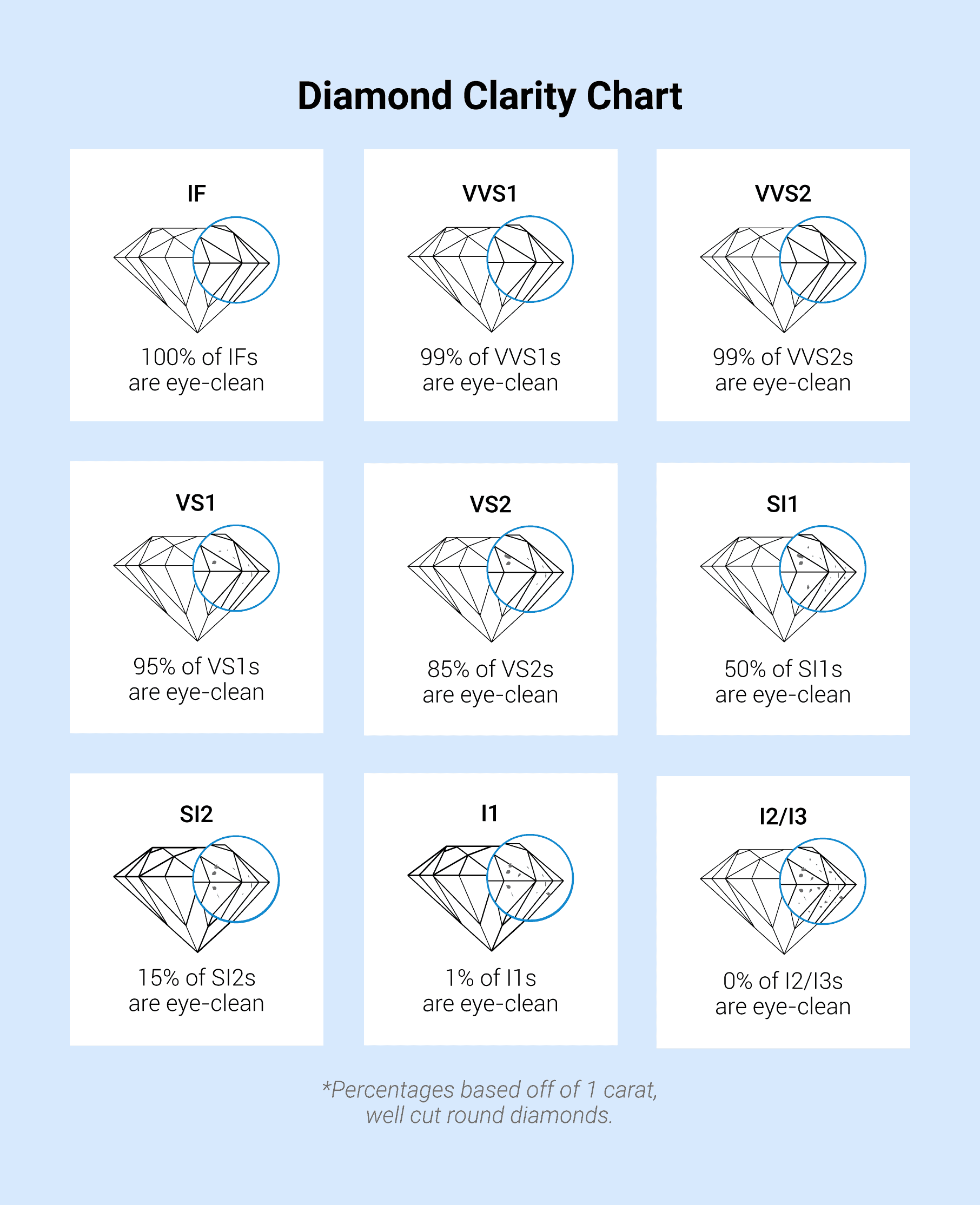
Depending on the size, location and darkness of blemishes and inclusions, these imperfections can interfere with light as it passes through the diamond. When this happens, the brilliance and beauty of the diamond is dulled, taking away from the high-quality cut.
For clarity, our primary recommendation is to ensure the diamond is eye clean, and that inclusions are not interfering with light reflection.
Review the stone to see if it is eye clean and ask for confirmation from an expert. A certificate alone won’t tell you how a diamond’s blemishes will impact the stone’s appearance and brilliance.
Eye-Cleanliness is Paramount
In our opinion, a consumer’s goal should be to find the cheapest (in regards to clarity; other factors matter as well) “eye-clean” diamond you can find. We use “eye-clean” to describe diamonds that may have inclusions if you look at them with a magnifying glass (or microscope or loupe), but the typical person can’t see the inclusion with their naked eye.
We have recently developed Ringo, a patented artificial intelligence model, that can examine videos of diamonds and determine if they are eye-clean. Ringo will also filter for other parameters like making sure the diamond is well-cut, doesn’t have fluorescence issues and will match the style setting you choose.
Often when people hear the term “carat weight,” they think it refers to the size of the diamond. In actuality, Carat refers to the weight of the diamond, not how large the stone is. A 1 carat diamond equals 200 milligrams, or 0.2 grams—and weighs about the same as a quarter of a raisin. Depending on the diamond shape and how it is cut, two 1 carat diamonds might be quite different in size.
While carat weight is an element to consider when buying a diamond, the overall appearance and brilliance should carry more importance. For example, a mediocre 1.5 carat diamond will not shine as brightly—or draw as much attention—as a stunning 1.0 carat diamond, no matter how much more it weighs. Rather than sticking to a certain number on the diamond carat weight chart, choose a diamond with an Excellent cut or Ideal cut in the shape you desire.
Each of the 4 C’s contribute to the overall beauty of a diamond and make each stone unique. A diamond, however, should be viewed as an organic whole. Because the eye has difficulty differentiating one diamond characteristic by itself, such as clarity or color, it is important to consider how the 4 C’s impact each other.
Cut is the most important of all the diamond characteristics as it most readily impacts a diamond’s beauty. Look for high levels of brilliance and fire, and be willing to reduce your spending in other areas like clarity or color to ensure an exceptional cut.
Cut: As mentioned above, cut is the most important of the 4Cs.
Color: The second most important aspect to focus on. A diamond should look white or colorless to the naked eye. Ensure the color does not distract or interfere with white and colored light reflection.
Clarity: The third most important characteristic on the list. Choose a diamond that is eye clean. Blemishes and inclusions should not distract from the brilliance or fire of a diamond.
Carat: Last but not least. Based on how you balanced out the other 3 C’s that will determine how large of a diamond you will end up with. If you balance everything perfectly, you will get the largest possible diamond in your budget that looks fantastic.
Most people are familiar with the 4Cs Cut, Color, Clarity, and Carat but some add a 5th “C” for Certification. The best diamond certification is from GIA and AGS because they’re the most consistent lab grading entities. That means you can trust their grading in all aspects like color, clarity and cut quality. These labs also grade more rigorously than other labs.
As a general rule, we suggest a high quality Cut above all else—as this greatly impacts a diamond’s beauty and brilliance—while balancing a fine line on Color and Clarity to get the best bang for your buck. With the right cut, even a J color like this can be a winner.
Knowing what to look for and how to balance the 4 C’s will help you get the best value for the perfect diamond for you.
Even with a basic understanding of the 4 C’s as a guide, navigating the diamond industry can be difficult. From picking which of the 4 C’s to prioritize, to assessing whether a diamond actually lives up to the grades it’s been given, there’s a lot to take in.
The recommendations related to cut, color, clarity and carat weight in this guide should give you a good starting point for your search. It also helps if you shop with a reputable vendor, as this dramatically lowers the chance that you’re going to get ripped off. For the best place to buy an engagement ring, we recommend James Allen, both of whom offer top-quality customer service, and an excellent range of diamonds at an amazing value.
We’re here to help with anything you need in your search for the perfect diamond. If you’re unsure how to evaluate a diamond and want to purchase an exceptional diamond that’s within your budget,
contact one of our experts for assistance.
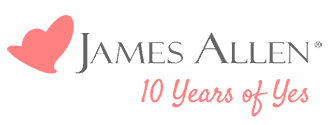



Before you buy a diamond, get personal buying advice from industry veterans. We'll help you get the best diamond for the money.
DISCLAIMER: We don't use your email for marketing. Period.
Please enter your email address to receive your 25% off coupon code:
Here is your coupon code: GFDSF3GF